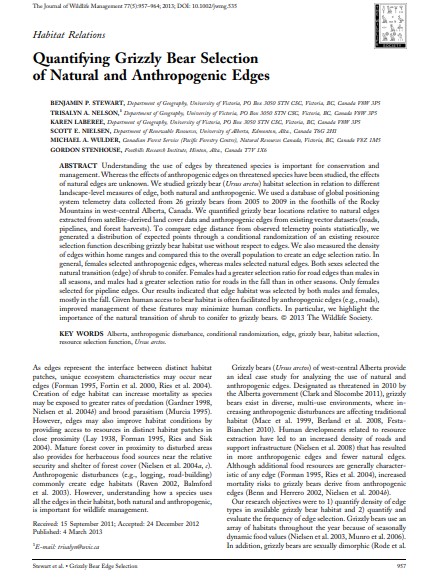Quantifying grizzly bear selection of natural and anthropogenic edges
Bosque Modelo:
Foothills
Temática:
Conservación
Tipo de documento:
Artículo científico
Resumen
Understanding the use of edges by threatened species is important for conservation and management. Whereas the effects of anthropogenic edges on threatened species have been studied, the effects of natural edges are unknown. We studied grizzly bear (Ursus arctos) habitat selection in relation to different landscape-level measures of edge, both natural and anthropogenic. We used a database of global positioning system telemetry data collected from 26 grizzly bears from 2005 to 2009 in the foothills of the Rocky Mountains in west-central Alberta, Canada. We quantified grizzly bear locations relative to natural edges extracted from satellite-derived land cover data and anthropogenic edges from existing vector datasets (roads, pipelines, and forest harvests). To compare edge distance from observed telemetry points statistically, we generated a distribution of expected points through a conditional randomization of an existing resource selection function describing grizzly bear habitat use without respect to edges. We also measured the density of edges within home ranges and compared this to the overall population to create an edge selection ratio. In general, females selected anthropogenic edges, whereas males selected natural edges. Both sexes selected the natural transition (edge) of shrub to conifer. Females had a greater selection ratio for road edges than males in all seasons, and males had a greater selection ratio for roads in the fall than in other seasons. Only females selected for pipeline edges. Our results indicated that edge habitat was selected by both males and females, mostly in the fall. Given human access to bear habitat is often facilitated by anthropogenic edges (e.g., roads), improved management of these features may minimize human conflicts. In particular, we highlight the importance of the natural transition of shrub to conifer to grizzly bears.
Información Bibliográfica
Autor:
Stewart, B.P., Nelson, T.A., Laberee, K., Nielsen, S.E., Wulder, M.A., & Stenhouse, G.
Revista:
Journal of Wildlife Management
Año:
2013
N°:
5
País :
Canadá
Páginas:
957 - 964
Volumen:
77
Idioma:
Ingles
Palabras claves
Alberta, anthropogenic disturbance, conditional randomization, edge, grizzly bear, habitat selection, resource selection function, Ursus arctos.





